top of page

Trigger your sparks.

01
Introduction to
Teams & Roles
CoBHS Chat (7)
Hi guys, I’m Eric Li.
I’m a team leader, researcher, and designer.
My role in this team includes:
-
Organize team meetings, create interview schedules, and coordinate with participants via emails
-
Lead and guide design process and brainstorming sessions, create design templates for presentations

Hi everyone, I’m Yimiao Wu.
I’m a researcher and design coordinator in this project.

Nice to meet you guys, I’m Lin Gong.
I’m a research coordinator and designer in this project.

Hi guys, my name is Hongyu Mao.
I’m a research coordinator and designer in this project.


Hi y’all, I’m Randy Bartlett.
I’m founder and Head of CoBHS, teacher, and educator.

Hello, my name is Jess Canose.
I’m Director of Community Engagement at CoBHS.

Hey! You might wonder who I am, but I’m a member of
the Pittsburgh community (I’m very important).
02
Randy Bartlett, head of City of Bridges High School in Pittsburgh, is planning on founding a local folk school. The new folk school is independent of CoBHS (although students of CoBHS can take courses at the folk school) and is meant to face the entire Pittsburgh community. “Everyone in Pittsburgh can become a teacher or student”, said Randy, defines the founding principle of the folk school.
Opportunity Summary & Background Research
Though having an ambitious picture in his head, Randy is having trouble finding out what community members of Pittsburgh are interested in teaching and learning and encouraging everyone to participate in the folk school. Despite a few personal connections he could rely on, Randy has an extremely preoccupied schedule and shoulders a number of other responsibilities. With the help of Jess, Director of Community Engagement of CoBHS, he is eagerly looking for a more systematic, sustainable approach to discovering community members’ interest in learning and potential of teaching.

Exterior

Classroom
CoBHS Students

Classroom


Name Cards
Kitchen
On the other hand, we also discovered a need of fostering interaction and communication between community members, who often come from a variety of socioeconomic and cultural backgrounds. As Randy said, “Pittsburgh does not lack talented people, but what’s lacking is interaction among each other”. Therefore, we felt strongly that we should first build an active community around the folk school even before it is founded.
The disconnection between CoBHS faculties and students with the community’s intellectual resources and the lack of interaction between community members are laying significant barriers to the successful founding of the folk school. How might we create a convenient and sustainable system to facilitate and encourage the sharing, interaction, and exploration of community members with diverse interests, hobbies, talents, or skills?
With this question in mind, we conducted a contextual inquiry and focus group activity with Randy and his students. The goal for us is to get the student's expectations and we designed some questions to prompt them to think about the possibility of folk school. For instance, we let them introduce their peers‘ special skills and things they wanted to learn from their community members and brainstorm what things they could offer to community members. We saw lots of opportunities where they could bring several pieces of their amateur life into the folk school. We then came together to draw connections and relationships between insights and created an affinity diagram to help us prepare for a synthesized model.

Eric Li
Yimiao Wu
CoBHS Students


03
Contextual Inquiry Synthesis Model
Based on our affinity diagram for the contextual inquiry and focus group activity, we developed a contextual inquiry synthesis model to find the commonplace and differences between Pittsburgh community values, CoBHS values, folk school objectives, and visions of folk school. We realized that community engagement lies at the heart of CoBHS education--this is reflected in the school’s core value that no one lives in isolation, and that students, even at a very young age, should and can be inspired and taught to make radiations to their community and society and become prepared for their future careers. Currently, CoBHS serves as a bridge that connects students to other community members through their community internship and apprenticeship programs.
The model helped us to discover two design opportunities: the first one is discovering connections and resources within the community, including what people want to teach and learn, and the second one is incentivizing community members to participate and form connections.

Pittsburgh does not lack talented people; what's lacking is interaction among each other.
--Randy
"
"
Therefore, we found three insights that should be addressed when designing the folk school:
The first insight is connection. Our design should focus on promoting community connection and providing people a place to exchange their resources and learn from others.
The second insight is people’s interests, which refers to encouraging people to share their interests, finding people’s interests, and aligning learners’ interests with folk schools’ curricula.
The third insight is the structure of the curriculum. The way we organize the folk schools should focus on the accessibility of classroom formats to people, with a focus on continuous attendance and reducing extra burden for teachers.
04
After meeting with members of CoHBS, we decided to collect further topics and expressions related to people's interests by means of Design Probe. Since Cultural Probe has the advantage of being able to solicit unexpected answers and ideas through a series of open-ended questions, it can broaden the scope of our design. Because we were able to give them the camera and let them contribute ideas and moments over a period of time, we designed a series of questions with openness and unexpected wording to inspire participants and made them into the form of booklets.
Design Probe & Ideation
I love learning from peers. It's amazing to see everyone's 'unknown' skills.
"
"
--one CoBHS student
We concluded from this Design Probe activity that skill sharing among students is actually ubiquitous, and that they are willing to share with their peers and have some experience with skill sharing activities. But this motivation was not systematically supported or helped by the idea of being able to participate in more random activities and having the opportunity, and the venue, to interact with others together. In addition, one of the most remarkable insights is that some of them are more aware of what skills others have than the founders themselves. Many times some people are reluctant to express themselves or show themselves, but such moments when others take pictures or praise them can make them feel confident.

Returned Booklet

Description of photos

Pockets to collect
photos

Photos taken by
CoBHS students
After the Design Probe activity, we came together to hold a brainstorm session, where each of us generated 5 ideas with wireframes and lo-fi prototypes that could represent our system or a part/function of our system. We then reviewed these design ideas and discovered four potential directions that could shape our final design solution: community platform, recommender system, curriculum design, and engagement incentive.
Example Wireframe

05
Storyboard
Speed-Dating



Feedback received
Colorful sticky notes
for feedback
In the next phase, we developed eight storyboards in the four potential directions identified in the previous stage: community platform, recommender system, curriculum design, and engagement incentive. We brought these storyboards to a speed-dating session with CoBHS faculties and students, where we provided them with colorful sticky notes to write down any comment, thought, or feedback they had regarding the ideas in the storyboards.

Lin Gong
Yimiao Wu
CoBHS Student
Based on the feedback, we discovered the following key insights:
1. The recommender system
According to our conversation with CoBHS students and teachers, the recommender system could address two issues. First, from the perspective of students, the system offers a platform for them to uncover their peers’ hidden skills, and helps students to realize what they are good at, which not only gives students confidence, but also provides them with an opportunity to learn from peers. Second, from the perspective of the folk school, the system helps the folk school to find potential teachers and curriculum topics.
I really like the idea that students, and in fact everyone, can become teachers...
"
"
--one CoBHS student
2. Students value human interaction
In the speed dating session, a student mentioned that he liked the idea of community platform because it allowed him to stay in touch with his friends even after graduation. Besides interaction with students, some students expressed their interests in communicating with community members. However, they are also concerned about how to reach out to community members, which our current design is lacking. Besides that, the interaction provided by the community platform is in the virtual world, our design needs to transform the virtual interaction into physical connection. In other words, how might we use the online community platform to attract community members attending the folk school. Therefore, our next step should focus more on the approaches to get more community members involved and promote the transition from digital communication to physical interaction.
Based on those insights, we refined our storyboards and focused on the recommender system aspect of our system.

PROBLEM
When Sam was browsing the platform, he found that Lucy was recommended to be a drawing teacher, and he was very eager to do so, but he was not sure what kind of skills he had.
SOLUTION
We provide an anonymous push platform where you can recommend anyone you know and her/his/their skills. When this number of votes and endorsements accumulates to a certain level, we will notify the candidate within the system and use some incentives to get her/him/them to try to start a class.
One day, Sam received a notification from the system that the founder of Folk School wanted to have an interview with him because everyone thought he had great communication skills.
RESOLUTION
Sam didn't realize he was good at this skill until he was informed, and he was happy that he was recognized by others, and decided to sort out and teach others his insights and ideas, by the way, to familiarize himself with these skills again.
Recommender System
(Community Member's Perspective)

PROBLEM
At the initial stage of course topic design, Randy was not sure how to define what to teach in order to attract more students to participate.
SOLUTION
We provide an anonymous push platform where you can recommend anyone you know and her/his/their skills. When this number of votes and endorsements accumulates to a certain level, we will notify the founder to reach out for that person.
After Randy called on everyone to adopt the platform, he quickly found a suitable candidate, Sam, who was good at communicating with people and wanted to learn communication skills from him.
RESOLUTION
With this system, Randy keeps finding and connecting with potential teachers for the folk school without much effort, so he continues using this system to explore more course topics.
Recommender System
(Folk School Founder's Perspective)
06
After receiving feedback from our speed-dating session, we narrowed down our design opportunities to the community platform and recommender system, where users can recommend and share with other people their skills and talents that might be suitable for folk school’s teaching. This system aims mainly at exploring and connecting with potential teaching resources for the folk school. We then developed a service blueprint to illustrate a typical path of engaging with our platform SPARK. The user journey can be divided into three phases: skill sharing, publishing or joining experiential online courses, and participating in offline courses.
Service Blueprint
1
3
2
Skill Sharing Platform.
Experiential Online (Offline) Courses.
Connection with Founders & Offline Courses
In the first phase, our platform can be interpreted as a skill sharing platform, which emphasizes the features of the recommender system. Each user has several “tags” that represent their skills. Users can customize their own or others’ tags, share their skills through posts, browse and like other users’ posts and tags.
When users receive enough likes or comments on their posts and tags, they might be motivated to develop an online experiential course to share skills to more people. In the second stage, users can publish an experiential course, co-teach with others (in case the user doesn’t have much experience or time in developing a course) and invite users to participate in their course.
After the user receive positive feedback for the experiential course, they will be contacted by Randy and establish a further connection with the folk school, and they might be invited to teach offline courses.

07
Final Prototype
Throughout the above research, it became clear that we are designing a supportive discussion and sharing platform to encourage community members to share their skills and discover their potential of teaching. Therefore, our mobile application contains three main pages: Nearby, Activities and Profile.

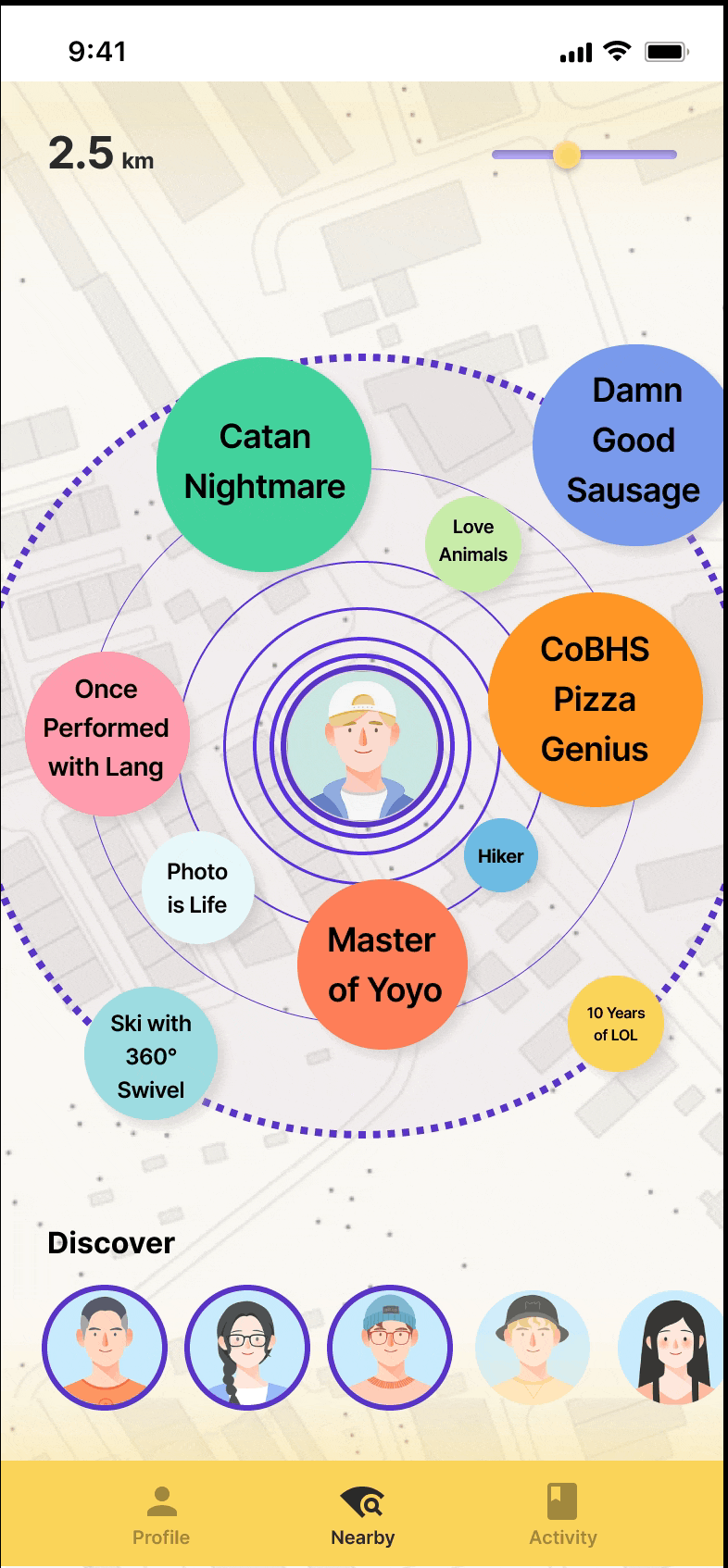




Nearby
In the Nearby page, users can browse the various skillful people around them on a spatial scale. Each circle represents a tag of a user. For example, the CoBHS Pizza Genius is a tag of another user, who is good at baking pizza. The user could click on that tag to browse the profile of the person behind the tag. The user can also access the content of posts for the tag by swiping the tab that represents the skill category like “Bakery”, and then interact with posts via emojis, likes and comments. The user can also create a new customized tag for that person if they happen to know a “hidden” skill of that person. This allows confidence building, skill sharing, and formation of connections and interactions amongst community members.
Profile
There are two main tabs in the profile page. One is Tags, where users can showcase their skills, edit their skills and posts contents. By clicking on the “Edit tags and post“ button, users can delete the tags showing to others, add new ones, and customize their highlights after choosing the right category. The other main tab is Activity, where users can view hosted, invited, and joined activities from the Activity page.
Activity
In the Activity page, the user can browse or search for nearby activities and its tags, time, location and number of participants. By swiping left of the activity, the can choose to join an ongoing online activity, sign up for an upcoming activity, or view activity details. For example, if the user is interested in origami, they can swipe left to sign up for this fun activity. Signed-up activities would appear under the Activity tab in the user’s profile page. The Activity page also helps Randy and Jess figure out the most heated topics around the community.

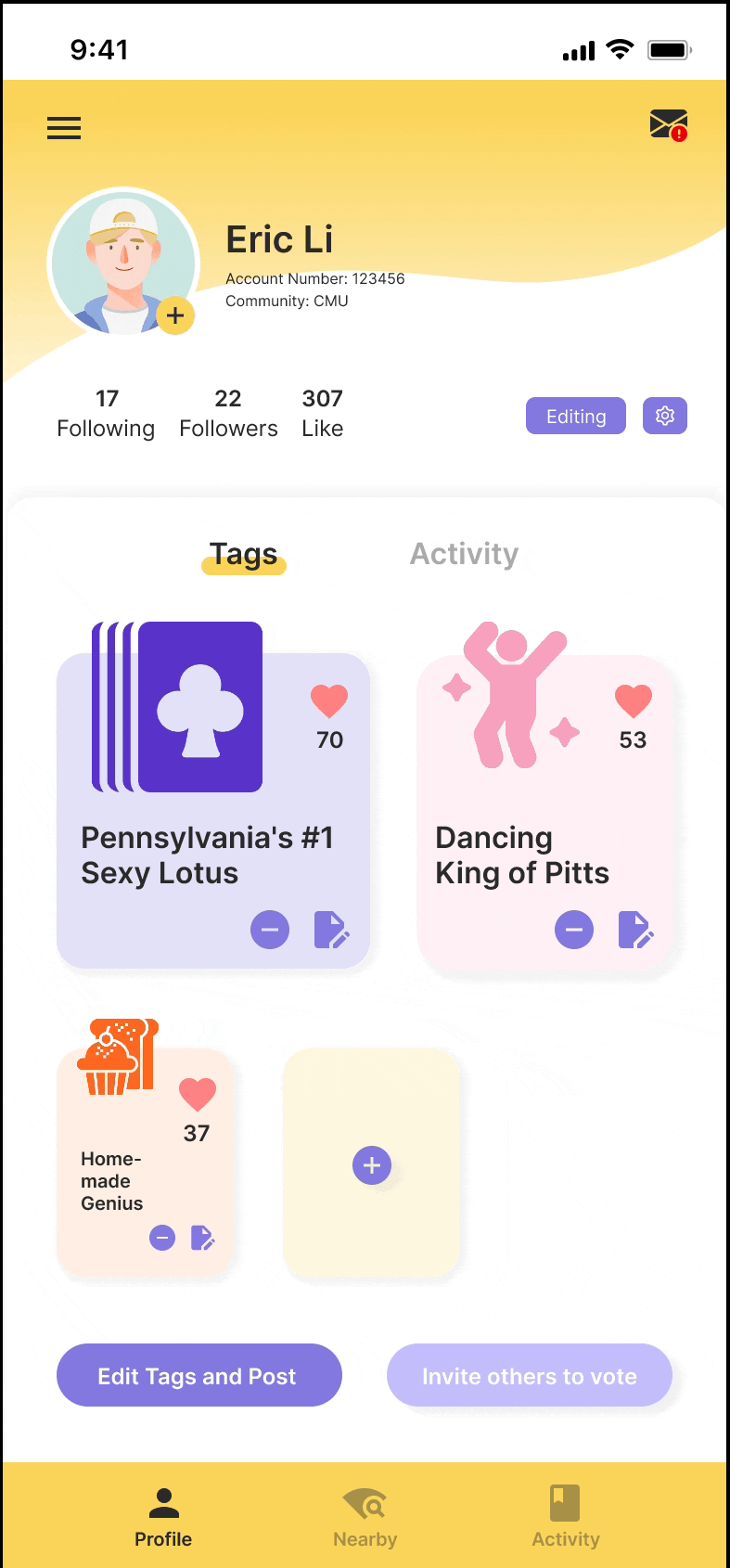


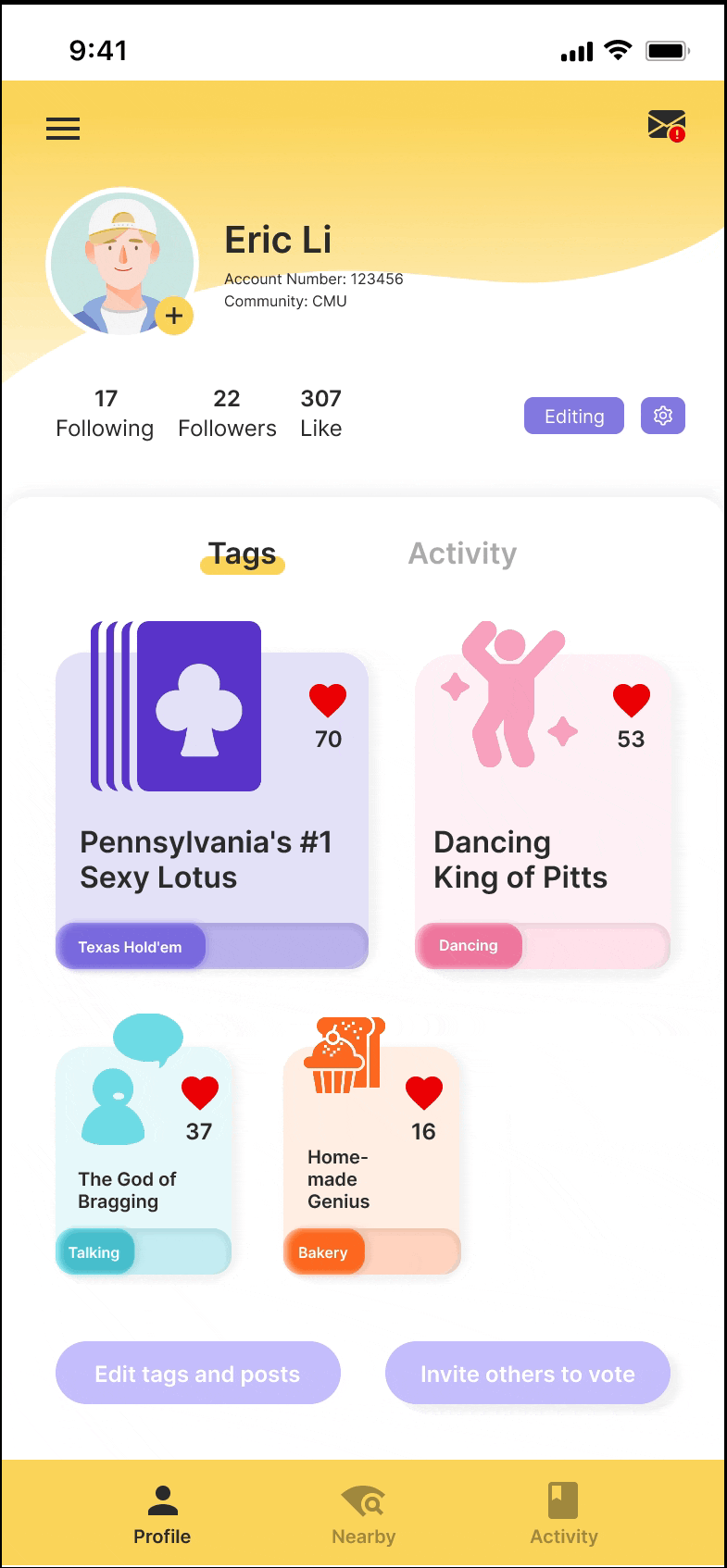


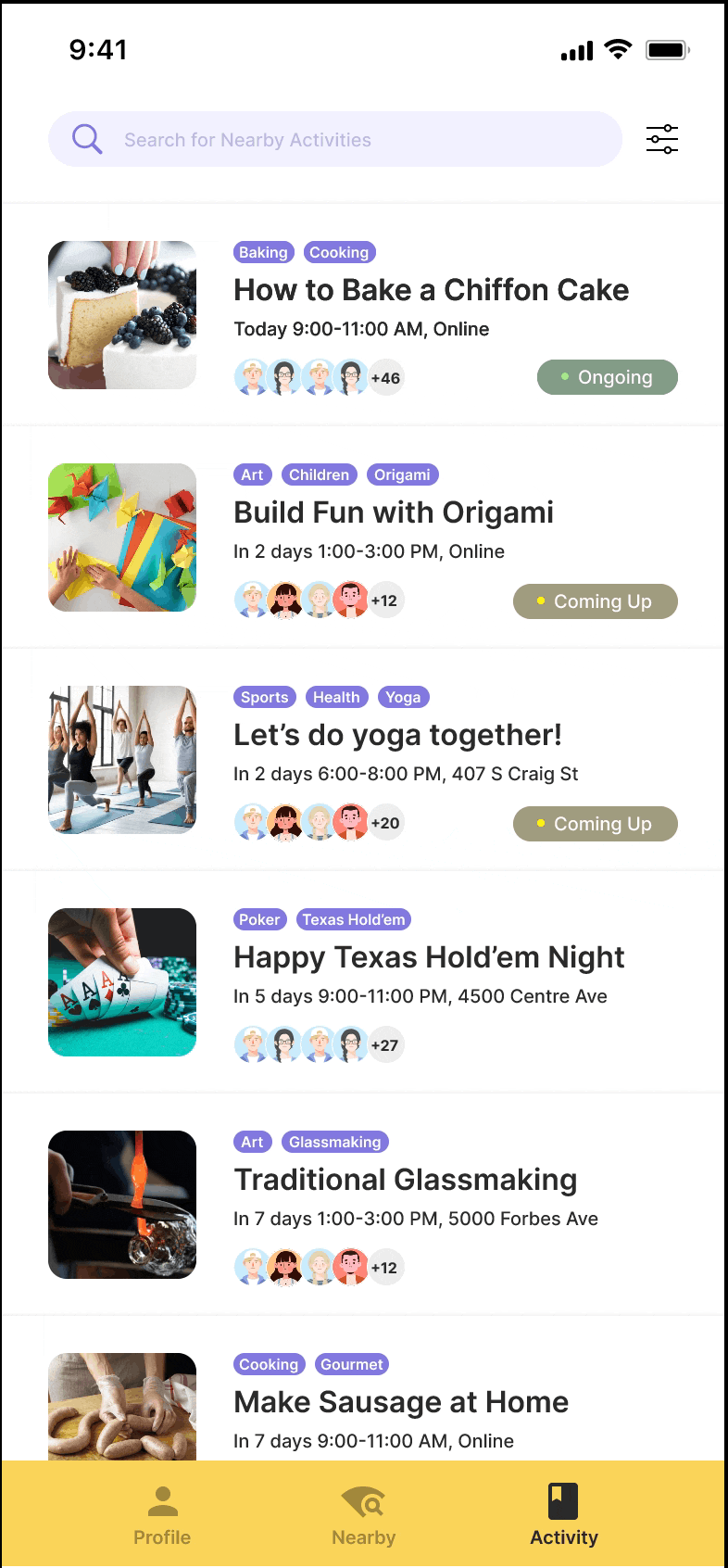


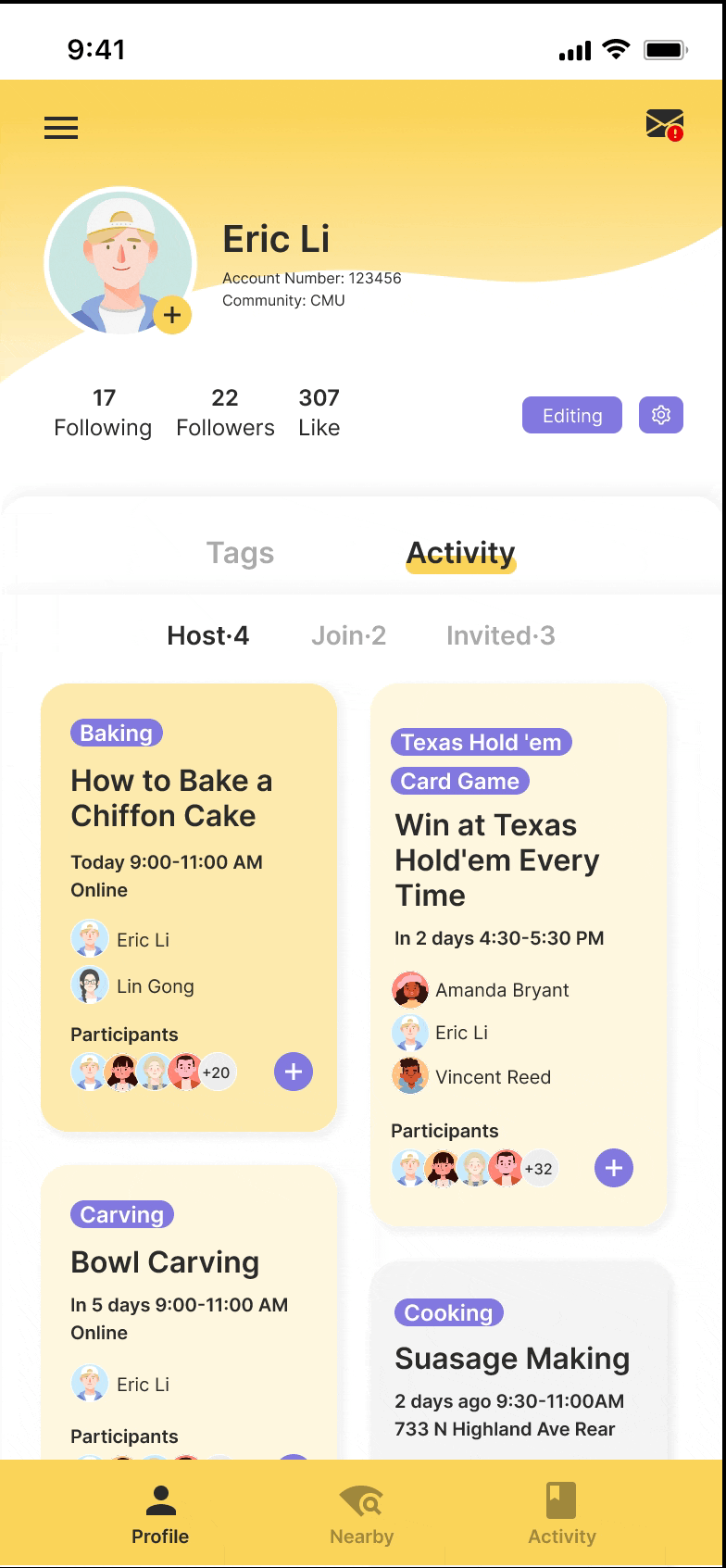

bottom of page
